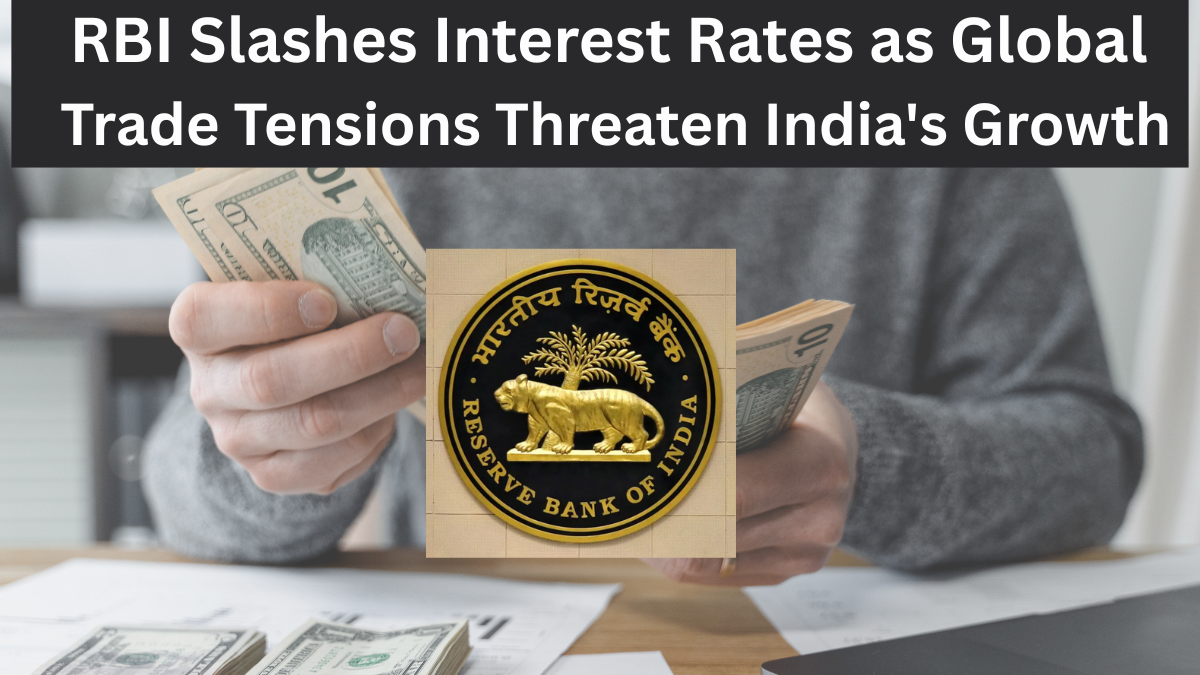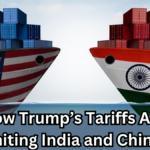In response to a challenging global economic environment and a series of unsettling trade tensions, India’s central bank, the Reserve Bank of India (RBI), has announced a 0.25% reduction in interest rates. This move comes after Donald Trump’s tariff announcements have put the brakes on global trade, particularly affecting India’s growth prospects. Let’s break down the key factors behind this decision and what it means for the Indian economy moving forward.

Why Did RBI Cut Interest Rates?
The RBI has reduced the repo rate—the rate at which it lends money to commercial banks—by 0.25%, bringing it down from 6.25% to 6%. This is the second rate cut since February 2024, signaling that the central bank is increasingly concerned about the slowing economic momentum. The repo rate directly affects borrowing costs for businesses and consumers, so when the rate is reduced, loans become cheaper, encouraging spending and investment.
What’s Behind the Rate Cut?
The global economic environment, primarily the US-China trade war and the resulting tariffs, has created a ripple effect across the world. India, being a major exporter, is feeling the heat from these global disruptions, and the RBI is stepping in to ensure that the Indian economy doesn’t lose momentum.
Key Developments:
-
New repo rate: 6.00% (down from 6.25%)
-
Growth forecast for India: Reduced from 6.7% to 6.5% for the year
-
Policy shift: The RBI has changed its stance from neutral to accommodative, signaling a greater willingness to cut rates further if needed.
How Does the Repo Rate Affect You?
The repo rate has a direct impact on borrowing costs for businesses and individuals. When the RBI cuts the repo rate, banks tend to pass on this reduction to consumers in the form of lower interest rates on loans. This, in turn, encourages borrowing, whether for businesses looking to expand or individuals purchasing homes or cars.
However, this is just one aspect of the RBI’s overall strategy. The accommodative policy means that the central bank is open to further rate cuts if the economy continues to face external and internal challenges.
The Global Trade Context: Tariffs and Slowdown
The US tariff hikes under the Trump administration have shaken up the global trading system, and India, as a major exporter, has not been immune to this turbulence. In response to these trade tensions, the RBI has revised its economic growth projections, predicting a growth rate of 6.5% for 2024-25, down from an earlier estimate of 6.7%.
How Will Tariffs Affect Indian Exports?
Starting this week, Indian goods exported to the US will face new tariffs of up to 27%. While these tariffs are significantly lower than those imposed on countries like China (up to 104%) or Vietnam and Cambodia (46-49%), they still pose a serious challenge for Indian exporters.
Impact of the Tariffs:
-
Higher costs for Indian exporters: The new tariffs will make Indian products more expensive in the US market, potentially reducing demand.
-
Reduced trade volume: With the US imposing tariffs, other countries may also reconsider their trade relations, creating a snowball effect on global trade flows.
-
Export sector slowdown: Industries that rely heavily on exports, such as textiles, machinery, and electronics, may see slowed growth due to diminished demand.
The RBI’s Stance on Global Economic Challenges
According to RBI Governor Sanjay Malhotra, global trade frictions are beginning to have a tangible effect on the Indian economy. He stated that these disruptions, particularly the ongoing trade war, could continue to pose challenges for India’s economic recovery.
Monetary Policy Shift:
-
The RBI’s accommodative stance is a clear signal that it is ready to take further steps to boost the economy if the situation worsens.
-
Interest rate cuts are expected to continue, with some economists suggesting that the total rate cut could reach 1% (100 basis points) by the end of this year, depending on how global trade tensions unfold.
India’s Growth Outlook: Will the Economy Still Expand?
Despite the challenges posed by trade wars and tariff hikes, India remains the world’s fastest-growing major economy. Even with the revision in the GDP growth forecast, India’s 6.5% growth rate is still enviable when compared to other major economies.
However, India’s growth trajectory has sharply fallen from the 9.2% recorded in the financial year 2023-24, indicating that the country’s economic momentum is slowing down.
What Does This Mean for India?
India’s growth is not immune to global conditions. The slowdown in global demand, particularly from the US and Europe, will affect India’s export-driven sectors, including automobiles, textiles, and chemicals. On top of that, the strengthening US dollar makes Indian exports more expensive for international buyers.
Key Risks:
-
External trade risks: A prolonged trade war and reduced global demand could hurt India’s growth.
-
Rising inflation: Even as the RBI cuts interest rates, moderating inflation remains a concern, especially as global commodity prices fluctuate.
The Future: What’s Next for India’s Economy?
The future of India’s economy will largely depend on how trade relations evolve, particularly with the US. While India is seeking a trade deal with the US to minimize the impact of tariffs, global factors such as the US-China trade war, Brexit, and slowing growth in Europe and China will still have significant effects.
Possible Scenarios for India:
-
Positive scenario: A successful Bilateral Trade Agreement with the US could soften the blow from tariffs, boosting India’s export potential and ensuring continued growth.
-
Negative scenario: If global trade disruptions continue or worsen, India’s GDP growth could slow further, and it may take longer for the economy to regain its momentum.
What the Experts Are Saying?
-
ICICI Bank: Economists predict that the repo rate could be cut by up to 100 basis points (1%) by the end of the year to support the economy.
-
HSBC: Estimates that India’s GDP could face a direct hit of 0.5% this financial year due to slower export volumes and weaker foreign fund inflows.
-
Moody’s: Has raised the chance of a global recession from 15% to 35% due to trade tensions, which would further affect India’s export-driven economy.
-
JP Morgan: Puts the chance of a global recession at 60%, significantly raising the risks for India’s external sector.
FAQs
1. What is the repo rate, and why does it matter?
The repo rate is the interest rate at which the RBI lends money to commercial banks. A lower repo rate encourages banks to reduce their lending rates, making it easier and cheaper for businesses and consumers to borrow money.
2. Why did the RBI decide to cut interest rates now?
The RBI’s decision is in response to slowing global growth, trade disruptions, and the uncertainty caused by new tariffs. The rate cut aims to stimulate the economy by reducing borrowing costs and encouraging spending and investment.
3. How will these tariff increases affect India’s economy?
The new tariffs on Indian exports to the US will raise the cost of Indian goods, potentially reducing demand in the US market. This could lead to lower growth for sectors reliant on exports, including textiles, machinery, and electronics.
4. What is the RBI’s accommodative policy stance?
The accommodative policy stance means that the RBI is open to further rate cuts in the future if the economic situation requires it. It signals the RBI’s willingness to take action to support the economy during periods of low growth and high uncertainty.
Conclusion:
India’s economic outlook is facing some headwinds, but it remains the world’s fastest-growing major economy. The RBI’s decision to cut interest rates is a proactive measure to stimulate growth amidst global trade disruptions. As the global economy continues to grapple with trade wars, tariffs, and recession risks, India’s future growth will depend on its ability to adapt to these changes while maintaining a strong domestic economy. The road ahead is uncertain, but with strategic moves and international cooperation, India can continue to forge a path of growth and resilience.
Click here to learn more




